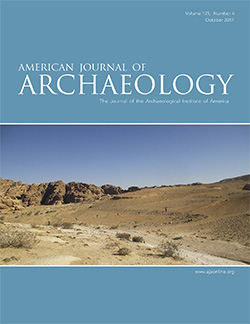AJA Open Access
BY-NCOctober 2017 (121.4)
Book Review
The Human Face of Radiocarbon: Reassessing Chronology in Prehistoric Greece and Bulgaria, 5000–3000 cal BC
Edited by Zoi Tsirtsoni
Reviewed by Konstantinos P. Trimmis
Collaborative projects between Balkan countries are scarce in archeological literature, mainly because of the complicated geopolitical events that have taken place during the last 150 years. Thus, any work like this one is to be welcomed since it enriches the poorly studied region of the Balkans. The Human Face of Radiocarbon is the main outcome of the Balkan 4000 project that was financed by the French National Research Agency and coordinated by Tsirtsoni between 2007 and 2011. The volume presents 192 new radiocarbon dates, analyzed in Greek (Demokritos) and French (Lyon and Saclay) laboratories, from 34 archaeological sites in Bulgaria and Greece, spanning the period from the end of the sixth to the beginning of the third millennium B.C.E.
According to the book’s back cover, the “main aim of the project was to shed light on the evolution of settlements during the late stages of the Neolithic period in Greece and Bulgaria, and more specifically on the transition from the Neolithic to the Early Bronze Age during the ‘obscure’ 4th millennium BC.” Thirty-one scholars, archaeologists, and radiocarbon scientists have contributed to this investigation of the decline in settlements and human presence that characterizes the final stages of the Neolithic in the southern Balkans.
A preface and 24 chapters constitute the volume itself. Twenty-one of the 24 chapters present case studies from archaeological sites in Bulgaria and northeastern central and southern Greece. Two chapters serve as an introduction, setting out the scope and overall aims of the research project. The editor summarizes the outcomes of the project and lists the concluding remarks from the reassessment of the available chronologies in a final chapter.
The volume in general is well organized, proceeding from north to south, although the inclusion of sites from southern Thessaly and central and southern Greece seems slightly out of context if we accept that Paliambela (southern Macedonia) is the southernmost site with clear “Balkan” Neolithic characteristics (Carpathian flint and a combination of Thessalian and central Balkan pottery styles). It would probably have been more beneficial to include the reassessment of sites from Greek Macedonia (e.g., the later phases of Paliambela) and Turkish Thrace (e.g., Asagi Pinar). In any case, the book has an interesting and thoughtfully selected anthology of sites that incorporates some very well-known settlements, such as Tell Karanovo and Dikili Tash, along with sites published here for the first time (e.g., Ayia Triada, Yagodina Cave, and Prodromos Karditsas).
The project methodology followed two axes. The first axis, the outcome of which is presented in the volume, included the production of new radiocarbon dates from several sites in a wide geographic context and the reassessment of existing dates in comparison with the archaeological evidence. The second axis focused on the collection of geoarchaeological and landscape data from the wider area of the sites, and this is partially discussed in the volume.
The project would have benefited from the inclusion of current techniques of mathematical modeling and Bayesian statistics in the research design to create a regional model of Late to Final Neolithic chronologies and to allow other researchers to place their results in a new and more precise time frame. Bayesian modeling in 14C dating allows researchers to link the dates with the stratigraphy of the site and other available contextual information. In the case of this publication, the editor was collaborating with the excavators of the case study sites and thus could have acquired this information. In the case of the Balkans, the possible modeling could also be linked with other projects that apply similar techniques in the northeast and north Balkans (Eurofarm and Times of Their Lives, respectively). The outcome would have been the first strong regional dating model for the Neolithic period. Statistical modeling would have added considerably to the project, making The Human Face of Radiocarbon not just a useful collection of dates and sites from the southeast Balkans but an essential tool for all research on the region’s Neolithic and Early Bronze Age eras.
Overall, this is a valuable publication that offers, as the editor writes, “a quite impressive series of 200 fresh, accurate and well contextualized C14 dates” (10) from an area that is somewhat understudied in comparison with other regions of the Balkans. The volume works also as a platform from which existing research projects—such as the excavations in Kataraktes, the Ayia Triada caves in Greece, and the settlement at Kosharna in Bulgaria—present their outcomes. However, the conclusions presented about the chronological reassessment of the Neolithic to Bronze Age transition, even if they are interesting, are not entirely convincing, mainly because they are based on an unscientific examination of the 14C dates and a comparable analysis of a few sites in a vast geographic context. Although I found the publication valuable and the outcomes promising, I was left with a feeling that something was missing for The Human Face of Radiocarbon to become an extraordinary milestone for the research of the Neolithic Balkans.
Konstantinos P. Trimmis
Cardiff University
trimmiskp@cardiff.ac.uk
